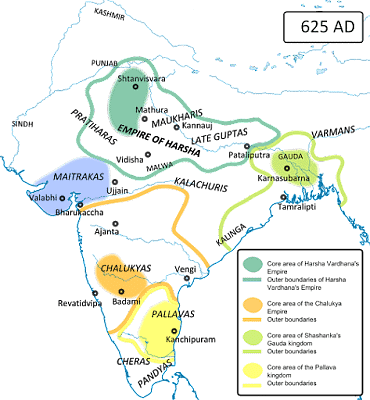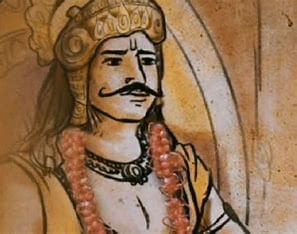Agrarian Structure in the Post-Gupta Period | History for UPSC CSE PDF Download
| Table of contents |

|
| Introduction |

|
| Know The Important Facts |

|
| Feudalism |

|
| The Pushyabhutis |

|
| Rule of Harsha |

|
Introduction
- Gupta rule: Signaled a shift in power consolidation.
- Land grants: Became frequent, indicating king's prerogative over all lands.
- Feudalism: Began to emerge, structured by the system of land grants.
- Baigram copper-plate: Highlights the acquisition and gifting of revenue-free lands to Brahmanas.
- Aksayanivi: Principle of permanent endowment, crucial in land grants.
- Damodar plates: Document instances of state land being sold for grants, with conditions like non-transferability altered.
- Land tenures: Included Aksayanivi for permanent endowments and Bhumichidranyaya for full property rights.
- Socio-economic transformation: Resulted from these practices during the Gupta period.

Know The Important Facts
Land Ownership and Rights:
- Cultivator-owned fields termed Kautambakshetra, individually owned as Sakta, and tilled by individuals as Prakrsta or Krsta.
- Free gifts of land categorized as aprada, sasana, chaturvaiayagrama, brahmadeya, etc.
- Bhaga refers to the royal share of produce, while Bhoga signifies periodic supplies provided to the king, and Kara denotes taxes paid alongside the grain share.
- Hiranya represents the king's share of certain crops payable in cash.
- Pratyaya encompasses various duties and obligations.
Land Tenures and Measures:
- In Gujarat, private individuals granted grama pattaka agreed to pay fixed amounts of land revenue in cash for entire villages.
- Land measures included nivartana, pattikahala, Kedara, bhumi, Khandukavapa, pataka, gocharma, kharivapa, kulyavapa, dronavapa, adhavapa, nalikavapa, etc.
Developments during Gupta Period:
- Temples and Brahmanas in northern and eastern Bengal, and eastern part of modern Madhya Pradesh, received cultivated land grants.
- From Vakataka king Pravarasena II onwards, rulers relinquished control over various revenue sources including pasturage, hides, charcoal, mines, salt production, and hidden treasures.
- Royal ownership of mines shifted to Brahmanas, and agrahara grants led to the rise of temporary tenants due to Brahmanas' inability to cultivate.
Post-Gupta Period:
- Land charters created a class of landed magnates with rights to collect taxes and maintain law and order.
- Free peasants retained significant land possession, paying revenues directly to the state.
- Peasants faced various impositions such as udranga, upanikara, hiranya, and forced labor.
- Granaries, village headman duties, and contributions to royal troops and officials were compulsory for villagers.
Local Production and Decline of Urban Centers:
- Rise of local units of production observed during Gupta and Post-Gupta periods.
- Local responsibility for irrigation.
- Habitation decline in many urban sites post-6th century AD.
- Nigamas (towns) issued coins during Gupta and post-Gupta periods, indicating the rise of a self-sufficient economy.
- Jajmani system prominence due to artisans catering to village needs.
Feudalism
 Indian Feudalism
Indian Feudalism
Origin of Indian Feudalism:
- Indian feudalism did not replicate the Western phenomenon but emerged uniquely within Indian society.
- It originated from the gradual evolution of Indian societal structures, rather than being imposed by external influences.
Definition of Feudalism:
- Feudalism in India is characterized by a social order where a possessing class appropriates surplus produce from peasants by asserting superior rights over land.
- Its political essence lies in organizing the administrative structure around land, while its economic structure is based on the institution of serfdom.
Political Aspect:
- The entire administrative structure in Indian feudalism revolves around land ownership.
- Landed intermediaries play a crucial role as buffers between the king and the actual tillers, asserting control over land and labor.
Economic Aspect:
- Indian feudalism relies on the institution of serfdom, where peasants are bound to the land and obligated to provide surplus produce to the possessing class.
- Peasants are not directly subjected to the king but are tied to the land through intermediaries who extract surplus produce and maintain control over the peasant population.
Distinct Features:
- Unlike Western feudalism, which arose from the dominance of a military class over peasants, Indian feudalism has its roots within Indian societal evolution.
- It is characterized by the dominance of landed intermediaries and the exploitation of peasant labor.
Unique Aspect of Indian History:
- Indian feudalism represents a unique aspect of Indian history, distinct from the feudalism observed in Western Europe.
- Its emergence and development are intertwined with the social, economic, and political dynamics of Indian society.
Essential Features of Indian Feudal System
- Theoretical Ownership of Land: Rulers theoretically owned all land within their domain.
- Land Grants:
- Various individuals received land grants, including princes, civil and military officers, priests, temples, and vassal states.
- Grants were made for services rendered, such as military or administrative duties.
- Fiefs and Feudal Grants:
- Fiefs were granted with the condition of paying fixed tribute or rendering military service.
- Feudal grants were tax-free and bestowed full administrative and hereditary rights.
- Fief holders could assign land to subordinates, leading to sub-infeudation.
- Feudal Hierarchy:
- A feudal hierarchy existed, comprising different strata of landed aristocracy between peasants and the king.
- The hierarchy included titles like Mahasamanta, Samanta, Ranaka, Thakura, Bhogika, Kutumbina, etc.
- Feudalism in India:
- In India, feudalism involved the ruralization of artisans and craftsmen.
- It led to the emergence of traditional Indian village communities.
- Broad Features of Indian Feudalism:
- Land granting, transfer of peasants, extension of forced labor, paucity of coins, and restrictions on movements of peasants, artisans, and merchants were prominent.
- Fiscal and criminal administration were abandoned, with the obligation of the Samantas (feudal lords) growing.
- Peasants were expected to be completely subservient to the land and its feudal overlords.
The Pushyabhutis
The predecessors of Harsha were all rulers of the land of Srikantha (Jhanesvar).
 The Pushyabhutis
The Pushyabhutis
Sources:
- Harsha Charitra, Kadambini and Parvathy Parinay of Bana.
- From the accounts of Hiuen-Tsang, the Chinese pilgrim.
- We get some information about the political condition in the dramas of Harsha such as Ratnavali, Nagananda and Priyadarsika.
- Nausasi copper plate gives us information about Harsha’s successful expedition against Valabhi. He defeated Dhruvasena II.
Introduction of the Personalities:
(i) Prabhakaravardhan—the first important king of this dynasty and the father of Harsha.
(ii) Rajyavardhan—Elder brother of Harsha.
(iii) Rajyashri—Sister of Harsha
(iv) Grahavarman—The Mankhari ruler of Kanauj and husband of Rajyashri.
(v) Sasanka—Ruler of Gauda or Bengal.
Rule of Harsha
- Rajyavardhan was killed by Sasanka.
- Harsha succeeded his brother. He rescued his sister and drove out Sasranka from Kanauj.
- He assumed the title of ‘Siladitya’.
- Chalukyan records of Pulakesin’s successors mention the defeat of Harsha by Pulakesin.
- Ravi Kirti (the court poet of Pulakesin II and the author of the Aihole inscription) also hints vaguely at Pulakesin’s victory.
- Rajasthan, Punjab, UP, Bihar and Orissa were under his direct control.
- Kashmir, Sind, Valabhi and Kamrupa acknowledged his sovereignty.
Administration
- Harsha governed his empire on the same line as the Guptas did, except that his administration had become more feudal and decentralised.
Bureaucracy
- Rajasthaniya (viceroys), or Lokapala or Uparika Maharaja (governors) or Samantas (feudatories). Mahabaladhikarita (officer in Supreme command of the army); Mahasandhivigra hadhikrita (supreme minister of peace and war); senapati (general), Brihadasavavara (head cavalry officer); katuka (commandant of the elephant forces); bhugika or bhogapati (collector of the state share of the produce); aksapatalika (keeper of records) etc.
- Harsha is credited with the grants of land to the officers by charters.
- The territory of the empire was called rajya or desa which was divided into bhuktis, vishyas and gramas.
Religion
- Harsha, in the early years of his reign, was a devout Shaiva, but then was liberal in his religious views.
- Brahmanism, which reasserted itself under the Guptas, got further strengthened during this period.
- Brahmanism was frankly given to idolatry.
- The most popular Brahmanical deities were Adhiya, Siva and Vishnu
- Buddhism appeared to be in a quite flourishing condition, but it had suffered decline in several localities like Kosambi, Vaishali and Sravasti.
- Jainism marked neither progress nor decay.
- Shaivism became the main theistic system of this period.
- Vedic ceremonies and rituals once again came to be regarded as integral constituents of Brahmanism.
- The assembly at Kannauj was held in honour of the Chinese pilgrim, Hiuen-Tsang, who became a great friend of Harsha.
- When the assembly at Kannauj was abruptly brought to an end, Harsha invited Chinese pilgrim Hiuen-Tsang to attend the quinquennial festival at Prayaga at the sacred confluence of the Ganges and the Yamuna.
|
216 videos|855 docs|219 tests
|
FAQs on Agrarian Structure in the Post-Gupta Period - History for UPSC CSE
| 1. What is Feudalism and how did it impact the post-Gupta period? |  |
| 2. Who were the Pushyabhutis and what role did they play in Indian history? |  |
| 3. How did the rule of Harsha impact society and culture during the post-Gupta period? |  |
| 4. What was the agrarian structure like in the post-Gupta period and how did it influence society? |  |
| 5. How did the decline of the Gupta Empire contribute to the rise of regional powers in India during the post-Gupta period? |  |





















